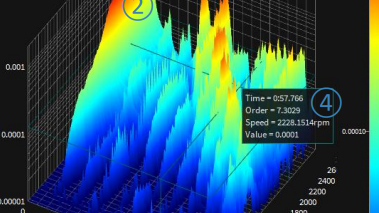Latest Oxygen 7.6 Update
Shunt Resistor Transducers
To measure current using a shunt resistor of known resistance (typically in the milli-Ohm range), the resistor should be connected in series with the Device Under Test (DUT) to ensure that the same current flows through both the DUT and the shunt. The voltage drop across the shunt can then be measured, which is directly proportional to the current (refer to Figure 2-1). This voltage is then quantified. By knowing the resistance of the shunt, the current can be calculated using the following formula:
I=U Shunt / R Shunt

Applications
- Laboratory applications with low current range
- Measurements on a 230V household grid if the circuit can be opened
Advantages
- Suitable for DC and AC measurements
- No separate sensor power supply required, because of direct current input
- High accuracy and bandwidth
Disadvantages
- Circuit needs to be opened for application
- Max current: typ. 20 ARMS
- Not isolated
Iron Core Current Clamps
The iron core based current clamp operates on the principle of a transformer (refer to Figure 3-1).

The primary wire (I1), carrying the current of interest, is threaded through the hole in the current clamp. In this configuration, the iron core surrounds the clamp's hole and forms a closed loop when the clamp is shut (see Figure 3-2). As the primary current flows through the wire, it generates a magnetic field within the iron core. This magnetic field, in turn, induces a secondary current in the wire (I2) wound around the iron core inside the current clamp. The magnitude of the secondary current depends on the number of windings around the iron core.


Typically, the primary wire consists of a single winding. For instance, assuming a current of 1 A in the primary wire and a secondary coil with 10 windings, the induced current in the secondary coil would be 100 mA.
To measure the secondary current, a shunt resistor is employed to capture the voltage drop it causes. The output voltage is commonly in the range of ±5 V or±10 V. This voltage is acquired by the data acquisition system and can be rescaled to obtain the original primary current value.
Applications
- For field tests where only AC needs to be measured
- For measurements with scope to check if current is conducted or not
Advantages
- No need to open circuit for application
- No separate sensor power supply required
- Quick mounting of sensor
Disadvantages
- Only suitable for AC measurements
- Low measurement accuracy
- Low signal bandwidth
- Low signal range
Hall Effect Transducers
When measuring current using hall effect current clamps, the current-carrying wire is passed through a hole in a similar manner as with iron core current clamps (refer to Figure 4-1). The magnetic field produced by the current is also induced into and enhanced by an iron core surrounding the hole of the current clamp.

The key difference between hall effect current clamps and iron core current clamps lies in the fact that the iron core of the former is not closed, but instead has an air gap at the opening of the clamp (refer to Figure 4-2). This air gap restricts the magnetic flow, preventing saturation of the iron core.

Within this air gap, a hall effect sensor is positioned. This sensor, made of semiconductor material, generates a hall voltage that is directly proportional to the magnetic field. Since the magnetic field is dependent on the current being measured, this voltage serves as a proportional representation of the current. However, due to the low magnitude of the hall voltage, an amplifier is employed for amplification. The output voltage is typically ±5 V or ±10 V. Consequently, the voltage can be measured and scaled to obtain the current value. The amplifier requires a power supply of approximately +9 V or ±15 V.

Applications
- For field tests where DC currents need to be measured
- For e-vehicle measurements during test drives
- Welding applications
Advantages
- No need to open the circuit
- Quick mounting of sensor
- Good measurement accuracy
- Good signal bandwidth
- High signal range
Disadvantages
- Measurement accuracy and signal bandwidth not sufficient for some applications (I.e. efficiency analysis)
- Separate sensor power supply required
Rogowski Coil Transducers
Current transducers utilizing the Rogowski principle operate as follows: a coil is wrapped around the current-carrying wire.
The current flowing through the wire generates a magnetic field that, in turn, induces a voltage within the coil itself, known as the Rogowski coil (refer to Figure 5-1).

The induced voltage u(t) depends on the current i(t) in the conducting wire in the following manner:

u(t) = M(di/dt)
M is the mutual inductance and can be determined according to this formula:
M = μ₀ NA / lₘ
The induced voltage is then subjected to integration in the subsequent stage, resulting in an output voltage that is directly proportional to the current flowing through the conducting wire. Typically, the output voltage ranges from ±5 V to ±10 V.
Since the integrator component requires a power supply, Rogowski coils commonly necessitate a power supply of +9 V or +12 V.
Applications
- Measurement on cables with big diameter and very high currents such as on transformers in power substations
Advantages
- No need to open the circuit
- Quick mounting of sensor
- Good measurement accuracy
- High signal bandwidth
- Flexible coils which allows great cable diameters (i.e. 30 cm)
- Very high signal range (>5 kA)
Disadvantages
- External power supply required
- No DC measurements
- Measurement accuracy not sufficient for many applications (I.e. efficiency analysis)
Zero-Flux Transducers
There are two distinct types of transducers that utilize this technology: zero flux current clamps and closed zero flux transducers.
The zero flux current clamp replaces the hall sensor with a solenoid, also known as a "fluxgate core,"and incorporates an additional compensation winding to eliminate offsets. This design enhances accuracy (typically 0.3%) and minimizes phase errors compared to hall effect current clamps (refer to Figure 6-1).

On the other hand, the closed zero flux transducer comprises four different measurement coils: two for AC measurements, one for DC measurements, and an additional compensation coil to reject noise (see Figure 6-2).
This unique design yields a measurement signal with exceptionally high accuracy and bandwidth, making the zero flux transducer the preferred choice for efficiency measurements and e-vehicle testbeds. The sensor's electrical circuit includes integrators and amplifiers, requiring an external power supply of approximately ±15 V. The output signal of the sensor is typically a current signal within the range of ±200 mA or ±2 A.


Applications
- Testbed applications with possibility to open the circuit for application
- Electrical drivetrain development
- Efficiency analysis of inverters
Advantages
- Best measurement accuracy in ppm range
- High signal bandwidth
- High signal range
- DC and AC measurements
Disadvantages
- Circuit needs to be opened for application
- External power supply required
Comparison of Different Transducer Types

As demonstrated, there exists a wide range of current transducers, each with its own distinct advantages and disadvantages that dictate their suitability for specific use cases. If you have any inquiries regarding the various sensor types and require assistance in selecting the appropriate one for your application, please don't hesitate to reach out to us. We are here to provide guidance and support.
Download a PDF copy of this blog here.




